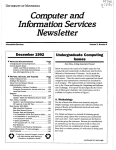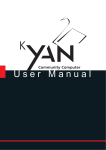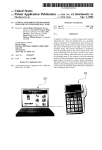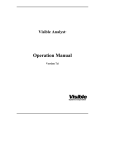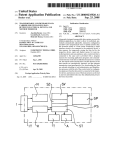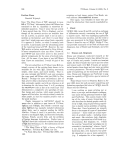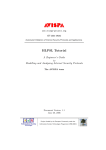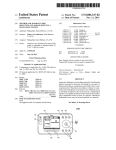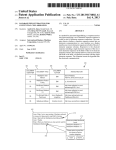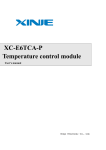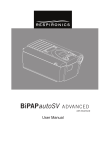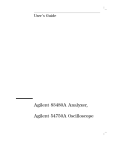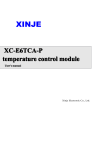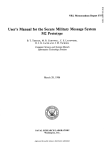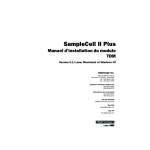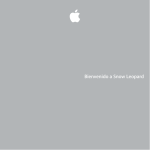Download (12) United States Patent
Transcript
US008701186B2
(12) United States Patent
(10) Patent N0.:
(45) Date of Patent:
Berg et al.
(54)
FORMAL ANALYSIS OF THE QUALITY AND
CONFORMANCE OF INFORMATION FLOW
DOWNGRADERS
(56)
US 8,701,186 B2
*Apr. 15, 2014
References Cited
U.S. PATENT DOCUMENTS
7,240,332
7,293,175
7,392,545
7,398,516
7,398,517
(71) Applicant: International Business Machines
Corporation, Armonk, NY (US)
(72) Inventors: Ryan J. Berg, Sudbury, MA (US);
Marco Pistoia, Amawalk, NY (US);
Takaaki Tateishi, Yamato (JP); Stephen
D. Teilhet, Milford, NH (US); Omer
B2
B2
B1
B2
B2
7/2007
11/2007
6/2008
7/2008
7/2008
Berg et a1.
Brown et al.
Weber et a1.
Berg et a1.
Berg et a1.
(Continued)
FOREIGN PATENT DOCUMENTS
Tripp, Har-Adar (IL)
(73) Assignee:
EP
JP
W0
International Business Machines
Corporation, Armonk, NY (US)
0 510 241 A2
2011013810
WO 2008/047351 A2
10/1992
1/2011
4/2008
OTHER PUBLICATIONS
(*)
Notice:
Subject to any disclaimer, the term of this
patent is extended or adjusted under 35
U.S.C. 154(b) by 0 days.
“The PACAP Prototype: A Tool for Detecting Java Card Illegal
Flow,” Bieber et al., Springer, Lecture Notes in Computer Science,
2001*
This patent is subject to a terminal dis
claimer.
Primary Examiner * Oscar Louie
(21) Appl. N0.: 13/804,362
(22)
Filed:
(74) Attorney, Agent, or Firm * Stephen J. Walder, Jr.;
Jeffrey S. LaBaW
Mar. 14, 2013
(65)
(57)
ABSTRACT
Mechanisms for evaluating downgrader code in application
Prior Publication Data
US 2013/0205391A1
(Continued)
Aug. 8,2013
code With regard to one or more security guidelines are pro
vided. Downgrader code in application code is identi?ed,
Where the downgrader code is a portion of code in the appli
Related US. Application Data
(63)
(51)
(52)
Continuation of application No. 12/968,646, ?led on
Dec. 15, 2010.
Int. Cl.
G06F 21/00
US. Cl.
USPC
(58)
726/22
Field of Classi?cation Search
USPC
the downgrader code, in the output of the downgrader code.
Processes of the downgrader code are evaluated against secu
rity guidelines to determine if the processes violate the secu
(2013.01)
.......................................................... ..
cation code that operates on an information ?oW of the appli
cation code to ensure con?dentiality of information input to
rity guidelines. A noti?cation is generated in response to the
evaluation indicating that the processes of the downgrader
code violate the security guidelines. The noti?cation is output
to a computing device for consideration.
.......................................................... .. 726/22
See application ?le for complete search history.
12 Claims, 5 Drawing Sheets
PROOEBEB
AGNNS'I' SECURITY
WIIELIES
IQ
US 8,701,186 B2
Page 2
References Cited
“Laminar: Practical Fine-Grained Decentralized Information Flow
U.S. PATENT DOCUMENTS
Control,” Roy et al., PLDI’09, Jun. 15-20, 2009.*
“Refactoring Programs to Secure Information Flows,” Smith et al.,
(56)
7,475,431 B2*
1/2009
7,530,101 B2
5/2009 Gallo et al.
7,530,107 B1*
7,617,489 B2
7,661,097 B2
7,849,509 B2
5/2009
Chao ............................. .. 726/30
Ono et al. ..................... .. 726/25
11/2009 Peyton et al.
2/2010 Lakshmankumar
12/2010 Venkatapathy et a1.
7,937,692 B2
7,975,257 B2
5/2011 Drepper
7/2011 Fanning etal.
7,987,451 B1
7/2011 Dalcher
8,104,021 B2*
1/2012 Erlingsson et al. ......... .. 717/126
8,365,281 B2
8,381,199 B2
1/2013 Tateishietal.
2/2013 Tateishietal.
8,468,605 B2*
6/2013
2002/0073313
2003/0051054
2004/0260940
2005/0108562
2006/0005019
2006/0150160
2006/0277539
2007/0016894
2007/0083933
2007/0088740
2007/0094646
2007/0107046
2007/0113292
2007/0150869
Haviv et al. ................... .. 726/25
A1
6/ 2002 Brown et al.
A1
3/ 2003 Redlich et al.
A1
12/ 2004 Berg et al.
A1
5/ 2005 Khazan et al.
A1* 1/2006 Chao ........................... .. 713/166
A1
7/2006 Taft et al.
A1
12/2006 Amarasinghe et al.
A1
1/ 2007 Sreedhar et al.
A1
4/ 2007 Venkatapathy et a1.
A1
4/2007 Davies et al.
A1
4/ 2007 Higham
A1* 5/2007 Jaeger et al. .................... .. 726/4
A1
5/2007 Kao et al.
A1
6/2007 Tateishiet al.
2007/0285271 A1*
12/2007 Erlingsson et al. .... .. 340/815.84
2008/0244536 A1
2008/0270993 A1
10/2008 Farchiet al.
10/2008 Tateishiet al.
2009/0138729 A1*
2009/0193492 A1*
5/2009 Hashimoto et a1. ......... .. 713/193
7/2009 Banerjee et al. ................ .. 726/1
2011/0072517 A1
3/2011 Tripp
2011/0087892 A1
4/2011 Haviv et a1.
2011/0088023 A1*
4/2011
Haviv et a1. ................. .. 717/155
2011/0131656 A1*
2011/0145785 A1*
6/2011
6/2011
Haviv et a1.
Centonze et al.
2011/0185345 A1*
7/2011
Swamy et al. .............. .. 717/146
2011/0321016 A1
.. 726/25
. 717/108
12/2011 Haviv et a1.
2012/0023486 A1*
2012/0084761 A1*
1/2012
4/2012
Haviv et a1. ................. .. 717/126
Maeda et al. ............... .. 717/132
2012/0131669 A1
2012/0159619 A1
5/2012 Tateishi et al.
6/2012 Berg et al.
PLAS’06 Jun. 10, 2006.*
“A Decentralized Model for Information Flow Control,” Myers et al.,
ACM, 1997.*
“Security Policies for Downgrading,” Chong et al., CCS’04, Oct.
25-29, 2004.*
“Data Security,” Denning et al., ACM, 1979.*
“JFlow: Practical Mostly-Static Information Flow Control,” Myers,
POPL, 1999.*
“A Lattice Model of Secure Information Flow,” Denning, ACM,
1976.*
“Secure Information Flow in a Multi-threaded Imperative Lan
guage,” Smith et al., POPL, 1998.*
“Protecting Privacy Using the Decentralized Label Model,” Myers et
al., ACM, 2001.*
“Language-Based Information-Flow Security,” Sabelfeld et al.,
IEEE, 2003.*
“Toward Automated Information-Flow Integrity Veri?cation for
Security-Critical Applications,” Shankar et al., In Proceedings of the
2006 ISOC Networked and Distributed Systems Security Sympo
sium (NDSS’06), 2006.*
“Securing Distributed Systems with Information Flow Control,”
Zeldovich, et al., NSDI ’08: 5th USENIX Symposium on Networked
Systems Design and Implementation, USENIX Association, 2008.*
International Search Report and Written Opinion dated Feb. 1, 2012
for International Application No. PCT/EP2011/069155, 12 pages.
U.S. Appl. No. 12/575,647.
US. Appl. No. 12/627,351.
US. Appl. No. 12/825,293.
US. Appl. No. 12/907,974.
US. Appl.
US. Appl.
US. Appl.
US. Appl.
No.
No.
No.
No.
12/950,432.
12/968,646.
13/248,724.
13/784,962.
Baldwin, Doug, “Constructing Regular Expressions from DFAs”,
SUNY Geneseo Department of Computer Science, Sep. 2006, http://
www.cs.geneseo.edu/~baldwin/csci342/fall2006/0919dfa2re.html,
5 pages.
Bracewell, Tom, “Raytheon Secure Systems and NetworksiAd
dressing the Challenge of Information Warfare”, Raytheon Technol
OTHER PUBLICATIONS
ogy Today, Issue 2, 2007, pp. 4-39.
Christensen, Aske S. et al., “Precise Analysis of String Expressions”,
“Modelling Downgrading in Information Flow Security,” Bossi et a1 .,
SAS’03, Proceedings of the International Static Analysis Sympo
sium, vol. 2694 ofLNCS, Jun. 2003, http://www.brics.dld~amoeller/
Proceedings of the 17th IEEE Computer Security Foundations Work
shop (CSFW’04), 2004.*
“SIF: Enforcing Con?dentiality and Integrity inWeb Applications,”
Chong et al., Department of Computer Science, Cornell University,
16th USENIX Security Symposium, USENIX Association, 2007.*
“The Compositional Security Checker: A Tool for the Veri?cation of
Information Flow Security Properties,” Focardi et al., IEEE, 1997.*
“On Practical Information Flow Policies for Java-Enabled Multiap
plication Smart Cards,” Ghindici et al., IFIP International Federation
for Information Processing, 2008.*
“Flow-sensitive, context-sensitive, and object-sensitive information
?ow control based on program dependence graphs,” Hammer et al.,
Springer, 2009.*
“Information Flow Analysis of Component-Structured Applica
tions,” Hermann, Computer Security Applications Conference,
2001 .*
“Downgrading Policies and Relaxed Noninterference,” Li et al.,
POPL’05, Jan. 12-14, 2005*
“Practical Information-?ow Control in Web-based Information Sys
tems,” Li et al., Proceedings of the 18th IEEE Computer Security
Foundations Workshop (CSFW’05), 2005.*
“Information Flow Control and ApplicationsiBridging a Gapi,”
Mantel, p. 153, Springer, 2001.*
“Enforcing Security and Safety Models with an Information Flow
Analysis Tool,” Chapman et al., SIGAda’04, Nov. 14-18, 2004.*
papers/strings/stringspdf, 17 pages.
Clarke, Edmund M. et al., “Model Checking”, The MIT Press,
XP002667219, 1999, 1page.
Cytron, Ron et al., “Ef?ciently Computing Static Single Assignment
Form and the Control Dependence Graph”, ACM Transactions on
Programming Languages and Systems, vol. 13, No. 4, Oct. 1991, pp.
451-490.
Deyle, Travis et al., “PowerPACK: A Wireless Power Distribution
System for Wearable Devices”, IEEE, 2008, pp. 91-98.
Elgaard, Jacob et al., “MONA 1.x: New Techniques for WSlS and
WS2S”, Computer Aided Veri?cation, Lecture Notes in Computer
Science, vol. 1427/1998, 10th International Conference, CAV’98,
Jun. 28-Jul. 2, 1998, http://www.brics.dk/mona/papers/monalx
new-technique-wsls-ws2s/article.pdf, pp. 516-520.
Engelfriet, Joost et al., “MSO de?nable string transductions and
two-way ?nite state transducers”, Leiden University, The Nether
lands, Institute of Computer Science, Technical Report 98-13, Dec.
1998, 62 pages.
Frankel, S. et al., “IP Security (IPsec) and Internet Key Exchange
(IKE)
Document
Roadmap
(RFC6071)”,
ipcom.com
IPCOM000203905D, Feb. 1, 2011, 127 pages.
Grove, David et al., “A Framework for Call Graph Construction
Algorithms”, ACM Transactions on Programming Languages and
Systems, vol. 23, No. 6, Nov. 2001, pp. 685-746.
Harvey, James D., “A Static Secure Flow Analyzer for a Subset of
Java”, US Navel Post-Graduate School, Mar. 1998, http://oai.dtic.
US 8,701,186 B2
Page 3
(56)
References Cited
OTHER PUBLICATIONS
Computer Science (including subseries Lecture Notes in Arti?cial
Intelligence and Lecture Notes in Bioinformatics), vol. 3858 LNCS
(2006), 26 pages, Recent Advances in Intrusion Detectioni8th
International Symposium, RAID (2005), Revised.
mil/oai/oai?verb:getRecord&metadataPre?x:html&
Reps, Thomas, “Program Analysis via Graph Reachability”, Univer
identi?erIADA343709, See Abstract: p. 6, 98 pages.
sity ofWisconsin, Technical Report #1386, Aug. 1998, pp. 1-31.
Henriksen, Jesper G. et al., “MONA: Monadic Second-Order Logic
in Practice”, Basic Research in Computer Science, BRICS Report
Roscoe, A.W. et al., “What is intransitive noninterference?”, Pro
ceedings of the 1999 IEEE Computer Security Foundations Work
Series, htth//WWW.bIICS.Clk/RS/95/2l/BRICS-RS-95-21.pdf, May
shop, 1999, 11 pages.
1995, 20 pages.
Klarlund, Nils et al., “MONA Version 1.4 User Manual”, Basic
Rosen, B.K. et al., “Global value numbers and redundant computa
tions”, Procs of 15th ACM SIGACT-SIGPLAN Symposium on Prin
Research in Computer Science, University of Aarhus, Denmark, Jan.
ciples of Programming Languages, Jan. 1988, 16 pages.
2001, 83 pages.
Kong, Deguang et al., “ISA: A Source Code Static Vulnerability
Detection System Based on Data Fusion”, Conference Info scale, Jun.
6-8, 2007, 7 pages.
Landwehr, C.E. et al., “Architecture and Components for Data Man
agement Security: NRL Perspective”, Naval Research Laboratory,
Center for High Assurance Computer Systems, Code 5542, Wash
ington, DC, 2007-2008, 6 pages.
Libkin, Leonid, “Elements of Finite Model Theory”, Springer,
XP002667220, Section 7.4, 2004, 2 pages.
Livshits, V.B. et al., “Finding Security Vulnerabilities in Java Appli
cations With Static Analysis”, 14th USENIX Security Symposium,
Jan. 1, 2005, 16 pages.
Livshits, Benjamin, “Improving Software Security With Precise
Static and Runtime Analysis”, Dissertation submitted to the Depart
ment of Computer Science and the Committee on Graduate Studies of
Standford University in partial ful?llment of the requirements for the
degree of doctor of philosophy, Nov. 2006, 250 pages.
Minamide, Yasuhiko, “Static Approximation of Dynamically Gener
Totseva, Silva M., “Provision of Seamless Web Services in a Multi
level Security Enviroment”, A Graduate Research Report Submitted
for IMAT 670 in Partial Ful?llment of the Requirements for the
Degree of Master of Science in Information Technology, University
of Maryland University CollegeiEurope, May 2009, 43 pages.
Tripp, Omer et al., “TAJ: Effective Taint Analysis of Web Applica
tions”, Proceedings of the 2009 ACM SIGPLAN Conference on
Programming Language Design and Implementation (PLDI’09),
Jun. 15-20, 2009, 11 pages.
Wassermann, Gary et al., “Sound and Precise Analysis of Web Appli
cations for Injection Vulnerabilities”, ACM, PLDI’07, Jun. 11-13,
2007, pp. 32-41.
Wassermann, Gary et al., “Static Detection of Cross-Site Scripting
Vulnerabilities”, ACM, ICSE’08, May 10-18, 2008, pp. 171-180.
Yu, Fang et al., “String Analysis”, Available at http://citeseerx.ist.psu.
edu/vieroc/summary?doi:10.1.1.84.3591, 2008, 15 pages.
International Search Report and Written Opinion dated Jan. 17, 2013
for International Application No. PCT/IB2012/053856, 9 pages.
Of?ce Action mailed Jul. 19, 2013 for US. Appl. No. 13/248,724; 15
ated Web Pages”, Proceedings of the 14th International Conference
on World Wide Web (WWW’05), May 10-14, 2005, pp. 432-441.
pages.
Mohri, Mehryar et al., “Regular Approximation of Context-Free
pages.
Terauchi, Tachio, “Secure Information Flow as a Safety Problem”,
Grammars Through Transformation”, In Jean-Claude Junqua and
Gertjan van Noord, editors, Robustness in Language and Speech
Technology, Dordrecht, 2001, 14 pages.
Moller, Anders et al., “The Pointer Assertion Logic Engine”, Procs.
of ACM SIGPLAN 2001 Conference on Programming Language
Design and Implementation, 2001, pp. 1-11.
Pietraszek, TadeusZ et al., “Defending against Injection Attacks
through Context-Sensitive String Evaluation”, Lecture Notes in
Of?ce Action mailed Sep. 6, 2013 for US. Appl. No. 13/248,724; 15
University of California, Berkeley, Jun. 2005, pp. 1-16.
Notice of Allowance mailed Oct. 16, 2013 for US. Appl. No.
12/968,646, 29 pages
Response to Of?ce Action ?led With the USPTO on Dec. 3, 2013 for
US. Appl. No. 13/248,724, 26 pages.
* cited by examiner
US. Patent
Apr. 15, 2014
Sheet 1 015
US 8,701,186 B2
104
106
FIG. I
206\ PROCESSING
UN|T(S)
210
20
202
\
208
\ .
GRAPHICS
PROCESSOR c:
NB’MCH
/
‘2’
MA|N
MEMORY
216
236
/
/
AUDIO
ADAPTER
8'0
204
240
\
BUS
238
BUS
SB/ICH
/
USE AND
DISK
CD-ROM
51%ng
OTHER
KEYBOARD
SEWCCE'E
PORTS
226
230
212
_>
232
MODEM
ROM
ADAPTER
234
FIG. 2
AND MOUSE
220
222
224
US. Patent
|
_
_
|
|
|
_
Apr. 15, 2014
_
_
_
_
_
CONTROLLER
m
_
Sheet 2 015
_
_
_
_
_
US 8,701,186 B2
_
_
_
_
'510
_
_
_
_
DOWNGRADER
DETECTION
ENGINE
DOWNGRADER
EVALUATION
ENGINE
|
|
I
E
E
I
|
'
I
'
I
|
|
I
I/O INTERFACE
m
DOWNGRADER
ABSTRACTION
ENGINE
SECURITY
GUIDELINES
ENGINE
I
I
w
w
:
I
L
_|
_
_
_
_
_
_
_
_
_
_
_
_
FIG. 3
_
_
_
_
_
_
_
_
_
_
_.
US. Patent
Apr. 15, 2014
Sheet 3 015
US 8,701,186 B2
@
STATIC SINGLE
ASSIGNMENT
FIG' 5
INSTRUCTIONS
@
+
CONSTRAINT
TRANSLATE
>
SOLVER
INSTRUCTIONS
m
TO PRODUCTION
RULES
m
V
+
CONTEXT-FREE
PRODUCTION
RULES WITH
GRAJAAAR
STRING
OPERATIONS
v
m
(
Zznappend
FIG. 6
EN
‘)
US. Patent
Apr. 15, 2014
US 8,701,186 B2
Sheet 4 0f 5
START
I
II
STATIC ANALYSIS TO PROVIDE
SINGLE ASSIGNMENTS OF
VARIABLES
m
I
TRANSLATE INSTRUCTIONS TO
PRODUCTION RULES
M
I
POINTER ANALYSIS ON THE
PRODUCTION RULES
M
FIG. 7
I
GENERATE CONTEXT FREE
GRAMMAR FROM PRODUCTION
RULES
M
V
IDENTIFY DOWNGRADER
m
COMPARE CFG WITH
SPECIFICATIONS OF
SECURITY FUNCTIONS
m
END
US. Patent
Apr. 15, 2014
US 8,701,186 B2
Sheet 5 0f 5
START
RECEIVE
FIG. 8
APPLICATION
CODE
5.19
+
>
GENERATE
IDENTIFY
‘
SCORE FOR
DOWNGRADER
'
V|QLAT|0N
CODE
m
m
I
FOR NEXT
COMPARE
SCORE TO
DOWNGRADER,
THRESHOLD(S)
GENERATE
TO CATEGORIZE
ABSTRACT
VIOLATION
REPRESENTATION
m
m
I
+
CHECK
EVALUATE
DOWNGRADER
PROCEssEs
AGAINST SECURITY
KNOWLEDGE
BASE FOR
SOLUTION TO
VIOLATION
GUIDELINES
m
m
I
IOLATION.
GENERATE
NOTIFICATION
OUTPUT
is!
YES
m
V
US 8,701,186 B2
1
2
FORMAL ANALYSIS OF THE QUALITY AND
CONFORMANCE OF INFORMATION FLOW
DOWNGRADERS
sify the extracted information, which now can become public
enough to be revealed to a public listener.
A program can implement many different types of down
graders. That is, these downgraders are used because a pro
gram should not accept any “high” input to a “low” function
This application is a continuation of application Ser. No.
m
unless that “high” input has been previously downgraded. A
particular downgrader operates for a particular speci?c subset
12/968,646, ?led Dec. 15, 2010, status pending.
BACKGROUND
of the set of “low” functions and thus, a program may be
required to implement a plurality of different types of down
The present application relates generally to an improved
data processing apparatus and method and more speci?cally
to mechanisms for static enforcement of application security
10
graders.
For example, an integrity “low” function that accepts an
input in the form of a string, concatenates that string into a
guidelines by using formal analysis of the quality and con
Structured Query Language (SQL) query, and then submits it
formance of information ?ow downgraders.
The Information-Flow Security principle establishes that
no “illicit ?ow” of information is allowed in a program. A
?ow is illicit if it allows untrusted information to be used in a
to a database. In this example, the function will require its
input not to contain semicolons and apostrophes, since such
characters will be interpreted by the database as SQL com
mands. Therefore, any input to this “low” function should
trusted computation (an integrity violation) or if it allows
have undergone sanitization (i.e. transformation of an illegal
input by removing/replacing suspect parts of the illegal input)
secret information to be entirely or partly revealed to unau
thorized users (a con?dentiality violation). Integrity and con
?dentiality can be seen as dual problems by simply stating
20
such illicit characters will that initially untrusted string be
accepted to be used in the SQL query.
However, if the “low” function is not responsible for per
that there should not be any ?ow of information from “high”
to “low”, where “high” means “untrusted” in integrity and
“secret” in con?dentiality, and low means “trusted” in integ
rity and “public” in con?dentiality.
25
Information can be tagged with information ?ow labels.
Typically, information ?ow labels form a partially ordered set
or a lattice. If information-?ow security was strictly enforced
and no illicit ?ow of information was allowed, most programs
would not work. To be “information-?ow secure,” a program
would have to be “partitioned” so that information tagged
with a certain label “X” can only ?ow to program points that
have been tagged with labels higher than or equal to “X”.
A program with these restrictions is very unlikely to be
useful. For example, from an integrity point of view, a Web
longer to prevent SQL injections, but rather to prevent what
30
plete a transaction, etc.
From a con?dentiality point of view, a Web application
often releases data that has been computed based on secret
information and, as such, should be considered secret as well.
For example, a banking application may reveal to any teller
the last four digits of the social security number of any user, an
online bookstore may reveal to any shop assistant the last four
digits of any customer’ s credit card number, etc. Given that all
these programs exhibit ?ows that allow “high” information to
?ow to “low” program points, all these programs would be
rejected if information-?ow security were simply enforced.
To permit these programs to function, “high” information can
be “downgraded” and become “low” enough to be used in
“low” program points.
Downgrading translates itself into “endorsement” in integ
rity and “declassi?cation” in con?dentiality. For example,
are known as Cross-Site Scripting C(SS) attacks. In this case,
the sanitization function must check for absence of speci?c
JavaScript tags, such as <script> and </scripts>.
Downgraders are often available in libraries, and are cat
egorized based on the speci?cations of the corresponding
“low” functions. Often, however, Web applications imple
35
40
the book that the customer wants to buy (all potentially
untrusted or malformed information), and uses them to com
forming SQL queries, but rather for concatenating its string
input value into HyperText Markup Language (HTML) code,
then a different sanitization is necessary. The issue here is no
application is supposed to accept inputs from potentially
untrusted users and use those inputs in trusted computations.
For example, an online banking program takes as input the
account number and the password of a user (potentially
untrusted or malformed information) and passes them to the
backend database system where they are used in a trusted
setting. In another example, an online bookstore takes as
input the user ID and pas sword of the customer and the title of
or endorsement, to make sure that such illicit characters are
not there. Only if a trusted sanitizer has veri?ed the absence of
45
ment their own downgrading functions. This makes security
static analysis of Web applications very complex. In fact, a
static analysis for information-?ow security should receive as
input the signature of the downgrading functions as well as
rules that map downgrading functions to the corresponding
“low” functions. At that point, the static analysis can verify
whether the input to a “low” function has always undergone
proper downgrading, without any path leading to a “low”
function unless its inputs have been properly downgraded.
Unfortunately, when Web applications implement their own
downgraders, it is very dif?cult to detect those downgraders
and categorize them in a way that the static analysis for
information-?ow security can subsequently account for
them.
Web applications are particularly vulnerable to security
50
attacks because they feed on user input and are typically
accessible by a large number of users. According to the Web
Application Security Consortium (WASC), approximately
100,000 security vulnerabilities were found an ?xed in 2008
55
with 52,587 of these vulnerabilities being either urgent or
critical. This illustrates the importance of protecting Web
applications against malicious inputs. This protection is typi
cally implemented using the endorsement/downgrader
mechanisms previously described above which either sanitize
60
the user’ s input (i.e. transform the input by removing/replac
ing suspect parts of the input) or validate the user’s input (i.e.
reject the user’s input if it is judged to be illegal).
once a program has veri?ed that the user-provided input to a
Sanitizers and validators can be thought of as the last (and
Web application is a properly formatted string, the program
most application-speci?c) line of defense against attacks.
These mechanisms usually embody subtle reasoning which is
meant to distinguish between legal and illegal inputs in vari
can endorse that input, which now becomes trusted enough to
be used in a trusted computation. Similarly, once a program
has veri?ed that the information extracted from a secret is not
suf?cient to reveal the secret itself, the program can declas
65
ous contexts. Moreover, these mechanisms themselves are the
interface between the security experts and the application
US 8,701,186 B2
4
3
developers. Writing them correctly is not a standard coding
task as a thorough understanding of security threats (in the
form of the long catalogue of known security attacks) is
required. Best practices, guidelines, and policies on how to
FIG. 2 is an example block diagram of an example data
processing system in which aspects of the illustrative embodi
ments may be implemented;
FIG. 3 is an example block diagram of the primary opera
tional elements of an application analysis mechanism in
create sanitization and validation mechanisms are often
found in security documents.
The challenge is to check whether these guidelines are
followed in the code of the Web application. There is cur
accordance with one illustrative embodiment;
FIG. 4 is an example diagram of a transducer which may be
utilized by the mechanisms of the illustrate embodiments to
rently no automated mechanism to carry out this check.
generate a context free grammar;
FIG. 5 is an example diagram illustrating a static string
analysis in accordance with one illustrative embodiment;
FIG. 6 is a call graph for an example program in accordance
SUMMARY
In one illustrative embodiment, a method, in a data pro
with one illustrative embodiment;
FIG. 7 is an example a block/?ow diagram that illustra
cessing system, is provided for evaluating downgrader code
in application code with regard to one or more security guide
tively depicts a system and method for static detection and
categorization of information-?ow downgraders in accor
lines. The method comprises identifying, by an application
analysis mechanism of the data processing system, the down
grader code in the application code. The downgrader code is
a portion of code in the application code that operates on an
information ?ow of the application code to ensure con?den
dance with one illustrative embodiment; and
FIG. 8 is a ?owchart outlining an example operation of an
20
automated application analysis mechanism in accordance
with one illustrative embodiment.
tiality of information input to the downgrader code, in the
output of the downgrader code. The method further com
DETAILED DESCRIPTION
prises evaluating, by the application analysis mechanism, one
or more processes of the downgrader code against the one or 25
more security guidelines to determine if the one or more
The illustrative embodiments provide mechanisms for
static enforcement of Web application security guidelines by
using formal analysis of the quality and conformance of infor
mation ?ow downgraders. In particular, the illustrative
embodiments provide automated mechanisms for checking
processes of the downgrader violate the one or more security
guidelines. Moreover, the method comprises generating, by
the application analysis mechanism, a noti?cation in
response to the evaluation indicating that the one or more 30 that downgraders in the code of an application, such as a Web
application (i.e. an application accessible via the World Wide
processes of the downgrader code violate the one or more
Web, or the Internet), and ensuring that the code of the appli
cation follows guidelines for implementing information ?ow
security guidelines. In addition, the method comprises out
putting, by the application analysis mechanism, the noti?ca
tion to a computing device.
In other illustrative embodiments, a computer program
product comprising a computer useable or readable medium
having a computer readable program is provided. The com
puter readable program, when executed on a computing
device, causes the computing device to perform various ones,
and combinations of, the operations outlined above with
regard to the method illustrative embodiment.
In yet another illustrative embodiment, a system/apparatus
is provided. The system/apparatus may comprise one or more
processors and a memory coupled to the one or more proces
downgraders. Based on this check, an output as to whether the
35
40
45
executed by the one or more processors, cause the one or more
detailed description of the example embodiments of the
present invention.
mechanisms whose goal is to approximate the set of runtime
values that string variables may assume. Example applica
tions of string analysis techniques to Web application security
sors. The memory may comprise instructions which, when
processors to perform various ones, and combinations of, the
operations outlined above with regard to the method illustra
tive embodiment.
These and other features and advantages of the present
invention will be described in, or will become apparent to
those of ordinary skill in the art in view of, the following
Web application is in compliance with the guidelines or
includes security violations may be generated.
The illustrative embodiments utilize string analysis
mechanisms. String analysis is a collection of techniques and
problems are described in co-pending and commonly
assigned US. patent application Ser. Nos. 12/575,647;
12/825,293; and 12/627,351, which are incorporated herein
by reference in their entirety. In particular, co-pending US.
patent application Ser. No. 12/ 575,647 describes a technique
for automated detection of information-?ow downgraders
using string analysis.
50
The mechanisms of the illustrative embodiments operate
orthogonally to the mechanisms of the Ser. No. 12/ 575,647
application directed to how to ?nd downgraders, e.g., sani
tizers and validators, in application code. Instead, the mecha
nisms of the illustrative embodiments are directed to deter
mining how the downgraders are structured and determining
55
if the structure meets established guidelines. The mechanisms
of the illustrative embodiments abstract away implementa
tion details of the downgrader and represent the downgrader
BRIEF DESCRIPTION OF THE SEVERAL
VIEWS OF THE DRAWINGS
as a sequence of manipulations on the downgrader’s inputs.
This abstraction is accomplished by modeling built-in string
The invention, as well as a preferred mode of use and
60
further objectives and advantages thereof, will best be under
stood by reference to the following detailed description of
example, a monadic second-order logic model may be used to
model the built-in string operations. The resulting high level
illustrative embodiments when read in conjunction with the
accompanying drawings, wherein:
FIG. 1 depicts a pictorial representation of an example
distributed data processing system in which aspects of the
illustrative embodiments may be implemented;
operations, as well as other instructions of interest. For
65
abstracted representation of the string operations can then be
examined and graded according to a set of guidelines. This
may be performed as an automated procedure for quantifying
the quality of the application’ s protection layer, i.e. the infor
mation ?ow downgraders of the application.
US 8,701 ,186 B2
6
5
The automated mechanism for evaluating downgraders
user’ s computer, as a stand-alone software package, partly on
the user’s computer and partly on a remote computer, or
entirely on the remote computer or server. In the latter sce
according to established guidelines can be used as an impor
tant bridge between application developers and security
experts as it allows the security experts to validate code
implementations of downgraders and communicate an evalu
ation to the application developers via a formal mechanism.
The automated mechanisms of the illustrative embodiments
nario, the remote computer may be connected to the user’s
computer through any type of network, including a local area
network (LAN) or a wide area network (WAN), or the con
particularly low such that they may be the reason for business
logic bugs, e.g., if their low score is due to the fact that they
nection may be made to an external computer (for example,
through the Internet using an Internet Service Provider).
Aspects of the present invention are described below with
reference to ?owchart illustrations and/or block diagrams of
eliminate input characters, instead of rejecting the input,
methods, apparatus (systems) and computer program prod
which leads to unintended behaviors in business-logic.
As will be appreciated by one skilled in the art, the present
program product. Accordingly, aspects of the present inven
ucts according to the illustrative embodiments of the inven
tion. It will be understood that each block of the ?owchart
illustrations and/or block diagrams, and combinations of
blocks in the ?owchart illustrations and/or block diagrams,
tion may take the form of an entirely hardware embodiment,
can be implemented by computer program instructions.
an entirely software embodiment (including ?rmware, resi
further are able to identify downgraders whose scores are
invention may be embodied as a system, method, or computer
20
These computer program instructions may be provided to a
processor of a general purpose computer, special purpose
computer, or other programmable data processing apparatus
to produce a machine, such that the instructions, which
thermore, aspects of the present invention may take the form
execute via the processor of the computer or other program
of a computer program product embodied in any one or more
25
mable data processing apparatus, create means for imple
menting the functions/acts speci?ed in the ?owchart and/or
block diagram block or blocks.
These computer program instructions may also be stored in
dent software, micro-code, etc.) or an embodiment combin
ing software and hardware aspects that may all generally be
referred to herein as a “circuit,” “module” or “system.” Fur
computer readable medium(s) having computer usable pro
gram code embodied thereon.
Any combination of one or more computer readable medi
um(s) may be utilized. The computer readable medium may
a computer readable medium that can direct a computer, other
be a computer readable signal medium or a computer read
programmable data processing apparatus, or other devices to
function in a particular manner, such that the instructions
stored in the computer readable medium produce an article of
able storage medium. A computer readable storage medium
may be, for example, but not limited to, an electronic, mag
system, apparatus, device, or any suitable combination of the
manufacture including instructions that implement the func
tion/ act speci?ed in the ?owchart and/or block diagram block
foregoing. More speci?c examples (a non-exhaustive list) of
or blocks.
the computer readable storage medium would include the
The computer program instructions may also be loaded
onto a computer, other programmable data processing appa
netic, optical, electromagnetic, infrared, or semiconductor
following: an electrical connection having one or more wires,
a portable computer diskette, a hard disk, a random access
30
35
programmable read-only memory (EPROM or Flash
memory), an optical ?ber, a portable compact disc read-only
memory (CDROM), an optical storage device, a magnetic
storage device, or any suitable combination of the foregoing.
In the context of this document, a computer readable storage
process such that the instructions which execute on the com
40
puter or other programmable apparatus provide processes for
implementing the functions/acts speci?ed in the ?owchart
and/or block diagram block or blocks.
The ?owchart and block diagrams in the ?gures illustrate
medium may be any tangible medium that can contain or store
a program for use by or in connection with an instruction
execution system, apparatus, or device.
A computer readable signal medium may include a propa
ratus, or other devices to cause a series of operational steps to
be performed on the computer, other programmable appara
tus, or other devices to produce a computer implemented
memory (RAM), a read-only memory (ROM), an erasable
the architecture, functionality, and operation of possible
45
implementations of systems, methods and computer program
products according to various embodiments of the present
gated data signal with computer readable program code
invention. In this regard, each block in the ?owchart or block
embodied therein, for example, in a baseband or as part of a
carrier wave. Such a propagated signal may take any of a
diagrams may represent a module, segment, or portion of
variety of forms, including, but not limited to, electro-mag
for implementing the speci?ed logical function(s). It should
netic, optical, or any suitable combination thereof. A com
code, which comprises one or more executable instructions
50
also be noted that, in some alternative implementations, the
puter readable signal medium may be any computer readable
functions noted in the block may occur out of the order noted
medium that is not a computer readable storage medium and
that can communicate, propagate, or transport a program for
use by or in connection with an instruction execution system,
apparatus, or device.
Computer code embodied on a computer readable medium
in the ?gures. For example, two blocks shown in succession
may, in fact, be executed substantially concurrently, or the
blocks may sometimes be executed in the reverse order,
55
may be transmitted using any appropriate medium, including
but not limited to wireless, wireline, optical ?ber cable, radio
frequency (RF), etc., or any suitable combination thereof.
Computer program code for carrying out operations for
and/or ?owchart illustration, can be implemented by special
purpose hardware-based systems that perform the speci?ed
60
aspects of the present invention may be written in any com
bination of one or more programming languages, including
an object oriented programming language such as JavaTM,
SmalltalkTM, C++, or the like, and conventional procedural
programming languages, such as the “C” programming lan
guage or similar programming languages. The program code
may execute entirely on the user’s computer, partly on the
depending upon the functionality involved. It will also be
noted that each block of the block diagrams and/or ?owchart
illustration, and combinations of blocks in the block diagrams
functions or acts, or combinations of special purpose hard
ware and computer instructions.
The illustrative embodiments may be utilized in many dif
ferent types of data processing environments including a dis
tributed data processing environment, a single data process
65
ing device, or the like. In order to provide a context for the
description of the speci?c elements and functionality of the
illustrative embodiments, FIGS. 1 and 2 are provided hereaf
US 8,701,186 B2
7
8
ter as example environments in which aspects of the illustra
tive embodiments may be implemented. It should be appre
ciated that FIGS. 1-2 are only examples and are not intended
to assert or imply any limitation with regard to the environ
ments in which aspects or embodiments of the present inven
and mouse adapter 220, modem 222, read only memory
(ROM) 224, hard disk drive (HDD) 226, CD-ROM drive 230,
universal serial bus (USB) ports and other communication
ports 232, and PCI/PCIe devices 234 connect to SB/ICH 204
through bus 238 and bus 240. PCI/PCIe devices may include,
tion may be implemented. Many modi?cations to the
depicted environments may be made without departing from
the spirit and scope of the present invention.
With reference now to the ?gures, FIG. 1 depicts a pictorial
representation of an example distributed data processing sys
tem in which aspects of the illustrative embodiments may be
implemented. Distributed data processing system 100 may
include a network of computers in which aspects of the illus
trative embodiments may be implemented. The distributed
data processing system 100 contains at least one network 102,
which is the medium used to provide communication links
between various devices and computers connected together
within distributed data processing system 100. The network
for example, Ethernet adapters, add-in cards, and PC cards for
notebook computers. PCI uses a card bus controller, while
PCIe does not. ROM 224 may be, for example, a ?ash basic
input/output system (BIOS).
HDD 226 and CD-ROM drive 230 connect to SB/ICH 204
through bus 240. HDD 226 and CD-ROM drive 230 may use,
for example, an integrated drive electronics (IDE) or serial
advanced technology attachment (SATA) interface. Super I/O
(SIO) device 236 may be connected to SB/ICH 204.
An operating system runs on processing unit 206. The
102 may include connections, such as wire, wireless commu
nication links, or ?ber optic cables.
20
In the depicted example, server 104 and server 106 are
connected to network 102 along with storage unit 108. In
addition, clients 110, 112, and 114 are also connected to
network 102. These clients 110, 112, and 114 may be, for
example, personal computers, network computers, or the like.
In the depicted example, server 104 provides data, such as
25
boot ?les, operating system images, and applications to the
clients 110, 112, and 114. Clients 110, 112, and 114 are
clients to server 104 in the depicted example. Distributed data
processing system 100 may include additional servers, cli
ents, and other devices not shown.
30
running the Advanced Interactive Executive (AIX®) operat
ing system or the LINUX® operating system (eServer, Sys
In the depicted example, distributed data processing sys
tem 100 is the Internet with network 102 representing a
worldwide collection of networks and gateways that use the
Transmission Control Protocol/Internet Protocol (TCP/IP)
tem p, and AIX are trademarks of International Business
Machines Corporation in the United States, other countries,
35
suite of protocols to communicate with one another. At the
heart of the Internet is a backbone of high-speed data com
consisting of thousands of commercial, governmental, edu
40
sages. Of course, the distributed data processing system 100
Instructions for the operating system, the object-oriented
programming system, and applications or programs are
located on storage devices, such as HDD 226, and may be
may also be implemented to include a number of different
types of networks, such as for example, an intranet, a local
area network (LAN), a wide area network (WAN), or the like.
As stated above, FIG. 1 is intended as an example, not as an
or both while LINUX is a trademark of Linus Torvalds in the
United States, other countries, or both). Data processing sys
tem 200 may be a symmetric multiprocessor (SMP) system
including a plurality of processors in processing unit 206.
Alternatively, a single processor system may be employed.
munication lines between major nodes or host computers,
cational and other computer systems that route data and mes
operating system coordinates and provides control of various
components within the data processing system 200 in FIG. 2.
As a client, the operating system may be a commercially
available operating system such as Microsoft® Windows®7
(Microsoft and Windows are trademarks of Microsoft Corpo
ration in the United States, other countries, or both). An
obj ect-oriented programming system, such as the JavaTM pro
gramming system, may run in conjunction with the operating
system and provides calls to the operating system from
JavaTM programs or applications executing on data processing
system 200 (Java is a trademark of Oracle and/or its af?liates
in the United States, other countries, or both).
As a server, data processing system 200 may be, for
example, an IBM® eServerTM System p® computer system,
loaded into main memory 208 for execution by processing
unit 206. The processes for illustrative embodiments of the
45
architectural limitation for different embodiments of the
present invention may be performed by processing unit 206
using computer usable program code, which may be located
present invention, and therefore, the particular elements
in a memory such as, for example, main memory 208, ROM
shown in FIG. 1 should not be considered limiting with regard
224, or in one or more peripheral devices 226 and 230, for
example.
to the environments in which the illustrative embodiments of
the present invention may be implemented.
50
With reference now to FIG. 2, a block diagram of an
A bus system, such as bus 238 or bus 240 as shown in FIG.
2, may be comprised of one or more buses. Of course, the bus
example data processing system is shown in which aspects of
system may be implemented using any type of communica
the illustrative embodiments may be implemented. Data pro
cessing system 200 is an example of a computer, such as
client 110 in FIG. 1, in which computer usable code or
instructions implementing the processes for illustrative
embodiments of the present invention may be located.
tion fabric or architecture that provides for a transfer of data
between different components or devices attached to the fab
ric or architecture. A communication unit, such as modem
222 or network adapter 212 of FIG. 2, may include one or
more devices used to transmit and receive data. A memory
may be, for example, main memory 208, ROM 224, or a cache
such as found in NB/MCH 202 in FIG. 2.
In the depicted example, data processing system 200
employs a hub architecture including north bridge and
memory controller hub (NB/MCH) 202 and south bridge and
55
60
input/output (I/O) controller hub (SB/ICH) 204. Processing
unit 206, main memory 208, and graphics processor 210 are
connected to NB/MCH 202. Graphics processor 210 may be
connected to NB/MCH 202 through an accelerated graphics
port (AGP).
In the depicted example, local area network (LAN) adapter
212 connects to SB/ICH 204. Audio adapter 216, keyboard
65
Those of ordinary skill in the art will appreciate that the
hardware in FIGS. 1-2 may vary depending on the implemen
tation. Other internal hardware or peripheral devices, such as
?ash memory, equivalent non-volatile memory, or optical
disk drives and the like, may be used in addition to or in place
of the hardware depicted in FIGS. 1-2. Also, the processes of
the illustrative embodiments may be applied to a multipro
cessor data processing system, other than the SMP system
US 8,701,186 B2
10
mentioned previously, without departing from the spirit and
including client computing devices, server computing
In order to provide one example of how downgrader code
may be identi?ed within application code, it is assumed that
the string analysis of the ’647 application is utilized. In such
a string analysis, application code is ?rst translated into a
context-free grammar (CFG) with string operations in a man
devices, a tablet computer, laptop computer, telephone or
other communication device, a personal digital assistant
Approximation of Dynamically Generated Web Pages,” Pro
scope of the present invention.
Moreover, the data processing system 200 may take the
form of any of a number of different data processing systems
ner such as described in Yasuhiko Minamide, “Static
ceedings of the 14m International Conference on World Wide
(PDA), or the like. In some illustrative examples, data pro
Web (WWW ’05), 2005), hereby incorporated by reference.
cessing system 200 may be a portable computing device
which is con?gured with ?ash memory to provide non-vola
tile memory for storing operating system ?les and/or user
The string operations are then removed from the context-free
grammar to generate production rules by applying approxi
mated string operation functions over CFGs which corre
generated data, for example. Essentially, data processing sys
spond to the string operations in the original application code.
tem 200 may be any known or later developed data processing
system without architectural limitation.
One or more of the computing devices in FIGS. 1 and 2
may be used to implement aspects of the illustrative embodi
ments. For example, a server computing device, such as
server 104 in FIG. 1, may be used to implement a Web
application that may be accessible by one or more client
computing devices, such as clients 110, 112, and 114. Before
deploying the Web application, or after implementation of the
Web application by the server 104, the mechanisms of the
illustrative embodiments may be employed to perform analy
sis of Web application to determine if the downgrader(s)
implemented by the Web application, or in conjunction with
These production rules are typically denoted by the form
NQXI . . . Xn, where N is a variable and X1 . . . Xn are
variables or characters and constitute the context-free gram
mar. The approximated string operation functions are func
tions that translate a CFG to another CFG, e. g., a transducer
that is a ?nite state automaton with output symbols. Applica
tion of the approximated string operations is iterated until
20
production rules without string operations.
That is, a program is represented as a context-free gram
25
the Web application, comply with security guidelines. The
mechanisms for performing the analysis of the Web applica
tion may be implemented in a server computing device, such
as, for example, the server 104 upon which the Web applica
tion is to be deployed or is already implemented, a client
30
mar, where the starting variable corresponds to the string you
are interested in approximating. Suppose, for example, that
this string is v in: “vwl .concat(v2);”. Computing the abstract
value of v requires knowledge of the abstract values of VI and
v2, and moreover, the “concat” operation needs to be
removed from the grammar by modeling its effect on v1 and
v2 once their values are known. This is what’ s meant above by
stating that application of the approximated string operations
computing device 110, 112, or 114, another computing
device, a plurality of computing devices, or the like.
is iterated until there are no more string operations in the
production rules.
FIG. 3 is an example block diagram of the primary opera
tional elements of an application analysis mechanism in
accordance with one illustrative embodiment. The elements
there are no more string operations in the production rules.
This results in a context-free grammar that consists of the
35
Suppose also that it is learned that v depends on v1 and v2,
so the approximation may considering v1 and v2 as the start
shown in FIG. 3 may be implemented in software, hardware,
ing variables recursively (each in turn). The original produc
or any combination of software and hardware. In one illus
tion rule is not necessary for obtaining the abstract values of
these strings (unless there’s a cyclic de?nition as discussed
further below). Once this recursive consideration of VI and v2
is performed, the operation returns to the grammar for v, and
applies a transducer approximating the effect of “concat”.
This yields a simpli?ed grammar, where the “concat” opera
trative embodiment, the elements of FIG. 3 are implemented
as software instructions executed by one or more processors
40
of one or more computing devices.
As shown in FIG. 3, the application analysis mechanism
300 comprises a controller 310, an input/ output interface 320,
a downgrader detection engine 330, a downgrader abstraction
engine 340, a downgrader evaluation engine 350, and a secu
rity guidelines engine 360. The controller 310 controls the
tion is no longer present, and in fact, the rule simply assigns
a value to v. Fixpoint iteration, rather than the above described
45
recursion, is needed to handle cyclic de?nitions, e.g., if the
overall operation of the application analysis mechanism 300
concatenation is done in a loop: The value of v at the i-th
and orchestrates the operation of each of the other elements
320-360. The input/output interface 320 operates to receive
inputs, such as Web application code for analysis, user inputs
iteration depends on its value in the (i—l)-th iteration.) As a
(if any) for con?guring the operation of the application analy
further example, consider the following JavaTM program
50
string aI“a”;
for (int i:0; i<3; i++)
sis mechanism 300, and the like. The input/output interface
320 operates to further generate outputs for providing noti?
cations to developers, security personnel, or other users to
inform them of whether or not a Web application’ s downgrad
ers meet established security guidelines or not, and if not,
which appends “a” to the string assigned to the variable a
three times after initialiZing it with the string value “a.”
55
what violations may be present.
string 1:21;
The following CFG is obtained by translating every appli
cation variable v into a nonterminal string variable Sv and “I”
The downgrader detection engine 330 analyzes application
into a—> as in production rules, where the string concatenation
code to detect in the application code where downgrader code
by + is considered to be a string concatenation on the CFG.
may be present. In one illustrative embodiment, the down
grader detection engine 330 may locate downgrader code
within application code using string analysis in a manner such
as described in co-pending and commonly assigned US.
patent application Ser. No. 12/575,647 (hereafter referred to
as the ’647 application). Of course, other known, or later
developed, mechanisms for detecting downgrader code
within application code may be used without departing from
the spirit and scope of the illustrative embodiments.
60
For example, the CFG with start symbol Sa represents a set
of possible string values assigned to the application variable
a, which yields the set of strings {“a”,“aa”,“aaa”,
65 “aaaa”, . . .
Likewise, the symbol S, represents a set of
possible string values assigned to the program variable r. It
contains strings
US 8,701,186 B2
11
12
that are never assigned to the variables a and r, since the string
the string analysis has been implemented on top of a static
analysis completely ignores the condition of the “for” state
analysis framework. The static analysis framework employed
ment.
may be any known framework and may include, for example,
When the application code uses prede?ned string opera
tions, such as String.substring as shown in the following
the Watson Libraries for Analysis (WALA), available as an
5
portion of application code, a sound approximation is used for
open source product from wala.sourceforge.net.
To describe the intra-procedural string analysis, consider
every string operation to translate a application code into a
the nappend method in JavaTM which is as follows:
CFG. For example, consider the prede?ned string operation
in the following portion of code:
String aI“xxa”;
public class MyClass {
static public void main(String args[ ]) {
String r:a.substring(2);
String a = “a”; String b = “b”;
Soundness of the approximated string operation means that a
String r = nappend(a, b, 3);
resulting CFG computed by the approximated string opera
tion contains all the actual strings computed by a prede?ned
public void nappend(String x, String y, int n) { String r = null;
if (n == 0) {
string operation that corresponds to the approximated string
r = x;
operation. One of the methods to approximate the prede?ned
}
string operation is to use a transducer which is an automaton
else {
with output.
Soundness may be formally de?ned as follows; f is a sound
r = nappend(x + y, y, n—l);
20
approximation for a string operation f iff S'Cf_(S) where
S":(s'|s':f(s), seS). One of the methods to ap?ximate pre
de?ned string operations is to use a transducer which is an
automaton with output. It is well known that the image of a
transducer is also a CFG. Other methods are homomorphisms
on Q, +) where Z is a set of characters and + denotes concat
25
In block 502, a translation of a program is made into Static
Single Assignment (SSA) form, where pseudo notations are
used for instructions. An example, translation is illustratively
enation functions that always return the same CFG yielding
shown as follows:
all the possible strings returned by corresponding prede?ned
string operations, and so on. The following production rules
with the approximated string operation substring(i,2) are the
ones obtained from the example portion of app ication code
return r;
main(String)
30
2. bI“b”
3. rInappend(a, b, 3)
above by using sound approximation:
nappend(String)
Srqubstring(Sa,2)
35
Referring now to FIG. 4, a transducer 400 is illustratively
. rl :nappend(v l, y, n— 1)
depicted. An approximated string operation substring(i,2) is
goto 8
de?ned by the transducer 400 and is a sound approximation
for the string operation substring(i,2). By applying the
depicted transducer 400 to the grammar consisting of the
above production rules, one can obtain the following CFG
goto 8
40
9. return r
which represents the set {"a",“aa”,“aaa”,“aaaa”, . . .
A call graph for this program is depicted in FIG. 6. Pseudo
notations used for instructions in the above program include
S'aQa
45
va/al for an assignment of a value val to a variable or a ?eld
The symbol A in FIG. 4 represents any character while A/e
v, v:obj.func(vl, . . . , vn) for a method invocation with
represents a transformation of any one character to the empty
arguments v 1, . . . , vn, goto N for an unconditional jump to the
string, which means removing the character. With a “sound”
transducer, the resulting abstract value is a safe approxima
tion of the strings that may result from the operation at run
50
time. Thus, for “substring(i,2)”, the representation simply
removes the ?rst two characters in the string, as indicated by
the labels A/e (essentially removes character A). A new CFG
is obtained which results from applying the transducer to the
original grammar.
data dependencies.
In block 504, the assignments in SSA form are translated to
55
After iteratively applying the above mechanisms to the
application code, a set of product rules representing the appli
described above (See FIG. 1 above). In particular, vrphi(vl,
v2) is translated into two production rules SVQSVl and
SVQSV2 so as to make it represent a union of the two sets of
60
Referring to FIG. 5, one illustrative embodiment will now
SleSxSy
be described for implementing a static string analysis in
accordance with the illustrative embodiments. The descrip
then explains how to extend that to inter-procedural string
analysis. The implementation details presented assume that
strings assigned to v1 and v2, respectively. According to this
translation, one can obtain the following production rules
from the pseudo SSA form of the nappend method.
s1s.
tion provided deals with intra-procedural string analysis, and
a set of production rules with string operations 506, except for
conditional and unconditional jumps, in the same manner
cation, but in which no string operations are present, is
obtained. Thus, a context-free grammar consisting of the
resulting production rules is the outcome of the string analy
label N, goto N if v for a conditional jump to the label N by the
condition v. In addition, the SSA transformation introduces
new variables and a (ID-function, which is denoted by phi(vl,
v2), to yield a program which has only one assignment to each
variable. This characteristic of the SSA form is suitable to ?nd
65
US 8,701,186 B2
14
13
For the inter-procedural string analysis, the intra-proce
such as a regular expression. This string pattern is given by an
dural string analysis is extended with the call graph informa
tion constructed by WALA, whose context-sensitivity can be
?exibly controlled by known methods. Every variable in the
may (or may not) be used in a security-sensitive operation.
SSA program is annotated with a call graph node. All the
unsafe strings since these characters are typically used by
production rules are combined after removing production
XSS (cross-site scripting) attacks. Therefore, regular expres
sions “.*[< >].*” (i.e. specifying that the “<” and “>” strings
rules
translated
from
method
invocations
such
analysis tool or a user, and it represents a set of strings which
For example, the strings “<” and “>” are considered to be
as
are not safe) may be part of a speci?cation for an information
?ow downgrader that is used to avoid the XSS attacks.
SrlQnappend (Svl,Sy,n—l). Production rules representing
dependencies between the parameters and the return value of
The one or more functions preferably include a security
a callee method and the variables of a caller method are
sensitive function in the application code. This may include
introduced. For example, the following production rules are
detecting and categorizing the downgrader functions based
introduced if a context-insensitive call graph 600 as shown in
upon a purpose of the downgrader function.
In block 712, the context free grammar is preferably com
pared with a speci?cation of an information-?ow down
FIG. 6 is present, where the superscript of each non-terminal
represents the corresponding call graph node. The production
rules are:
grader, such that if the grammar satis?es the speci?cation, the
input is considered properly downgraded. Comparison
between a context-free grammar and a speci?cation of a
20
regular expression can be done, for example, by a CFL reach
ability algorithm, as described in the paper “Program Analy
sis via Graph Reachability” by Thomas Reps, University of
Wis., August 1998.
A complete set of the production rules with string opera
The one or more function speci?cations are employed to
25
categorize the downgrader function as being a correct down
grader for one or more security vulnerabilities, for example. It
30
is assumed that there are multiple string patterns (regular
expressions) each of which is corresponding to a security
vulnerability, such as cross-site scripting (XSS) and HTTP
Response Splitting (HRS). When there are string patterns for
XSS and HRS, for example, the obtained context-free gram
tions 506 obtained from the program includes:
mar is compared with those two string patterns. If the inter
section of the context-free grammar with the XSS pattern is
not empty, the corresponding function is detected as a correct
An optional pointer analysis may be performed that helps
the string analyzer or solver 308 to identify how constant
strings ?ow to variables across methods and to identify
whether the same objects are assigned to different variables in
potentially different methods, even if those objects are
dynamically created. In block 510, the following CFG is
obtained that predicts possible strings assigned to the variable
r in the main method, where the start symbol is Srl.
Referring to FIG. 7, a block/?ow diagram illustratively
depicts a system and method for static detection and catego
rization of information-?ow downgraders in accordance with
the illustrative embodiments. The system and method shown
in FIG. 7 may be implemented in the downgrader detection
engine 330 in FIG. 3, for example, for detecting portions of
code in application code that correspond to downgraders.
As shown in FIG. 7, in block 702, a program stored in a
memory device, which may have been provided from a sepa
35
information ?ow downgrader for XSS, where the intersection
can be computed by the CFL reachability algorithm men
tioned above, for example. Likewise, if the intersection of the
context-free grammar and the HRS pattern is not empty, the
corresponding function is detected as a correct information
?ow downgrader for HRS. It should be noted that the function
40
may be detected as a correct information ?ow downgrader for
both XSS and HRS as well in this example. Of course the
present invention is not limited to XSS and HRS, but may be
used with any known or later developed security vulnerabili
ties.
45
Another type of string analysis that may be employed, and
which is used in illustrative embodiments of the present
invention, uses a monadic second-order abstraction of the
downgraders to perform string analysis. Referring again to
FIG. 3, having identi?ed one or more downgraders in the
50
application code in some manner, such as the manner
described above, the downgrader abstraction engine 340 is
rate device via the input/output interface 320 in FIG. 3, for
employed to build an abstract representation of the down
example, is transformed by statically analyzing program vari
graders. That is, the downgrader abstraction engine 340 may
be applied to each downgrader identi?ed in the application
ables to yield a single assignment to each variable in an
instruction set. This includes transforming the application
code by employing pseudo notations for program variable
55
assignments.
In block 704, the instruction set is translated to production
rules with string operations in a manner as described above,
for example. In block 706, a pointer analysis, as is generally
known in the art, is optionally performed on the production
code so that a separate abstract representation of the down
grader is generated to model the downgrader.
In one illustrative embodiment, the downgrader abstrac
tion engine 340 may implement monadic second-order logic
on strings in the downgrader where the downgrader’s code is
60
represented as a formula in monadic second-order logic. An
rules with string operations to improve precision.
example implementation of monadic second-order logic as
applied to strings is described in Elgaard et al., “MONA 1.x:
In block 708, a context-free grammar is generated from the
production rules. In block 710, an information-?ow down
brics .dk/mona/papers/mona lx-new-technique-ws l s-ws2 s/
grader function is identi?ed by checking the context-free
grammar against one or more function speci?cations. The one
or more function speci?cations consist of a string pattern,
New Techniques for WS 1 S and WS2S,” available from www.
65
article.pdf, which is hereby incorporated by reference herein.
With this monadic second-order logic, instructions in the
downgrader code that do not manipulate the input to the
US 8,701 ,186 B2
15
16
downgrader code are either ignored, if possible, or repre
sented in a way that re?ects the instructions’ in?uence on the
example, if it is determined that the downgrader mutates the
input to generate a sanitized output from the downgrader, and
downgrader’s result. For example, a test of the form “if (in
the above security guideline is in place, then the downgrader
put.contains(”xyz“)){ . . . }” is represented by asserting,
evaluation engine 350 may check the knowledge base 354
inside the body of the condition, that the input contains string
based on the detected violation as well as other information
“XyZ'”
about the structure of the downgrader code which may be
Again referring to FIG. 3, using the abstract representation
generated by the downgrader abstraction engine 340, the
extracted using the static-analysis mechanisms, and recom
mend that the downgrader code be modi?ed to replace the
downgrader evaluation engine 350 evaluates the way in which
the downgrader processes the input to the downgrader code in
the application code, e.g., evaluating the way in which a
sanitization elements of the downgrader code that mutate the
input with portions of code that either accept or reject the
input without mutating the input.
sanitizer operates to transform or remove/replace suspect
parts of the input or the way in which a validator judges
In some illustrative embodiments, the downgrader evalua
tion engine 350 may further include downgrader scoring logic
356. The downgrader scoring logic 356 operates to identify a
whether an input is illegal or not and determines whether or
not to reject the input. This evaluation involves comparing the
degree to which a downgrader diverges from the established
downgrader processing of input against a speci?cation, such
as a set of formal security guidelines specifying how down
security guidelines provided by the security guidelines
graders should operate. For example, the security guidelines
engine 360 may provide pre-established security guidelines
engine 360 and quantify this degree of divergence to generate
that set forth a set of rules and conditions under which down
a score for the downgrader. For example, the score may be
20
rity guidelines violated where the weight is associated with
the particular security guidelines violated to thereby indicate
established security guidelines may be de?ned by security
personnel and set forth in a database or other data structure
associated with the security guidelines engine 360. The secu
simply a count of a number of security guidelines violated by
the downgrader code, a weighted count of a number of secu
graders are required to operate in order to avoid any security
issues with the operation of application code. These pre
a priority of security guidelines, or the like.
25
rity guidelines engine 360 may provide one or more user
The score for a downgrader, once calculated in the manner
interfaces through which such security personnel or other
described above based on its divergence from established
security guidelines, may be compared to one or more estab
users may de?ne and store such security guidelines in the
lished threshold values to obtain an indication of which
database or data structure.
downgraders are considered to represent mild, moderate, or
For example, assume that a pre-established security guide
line for the downgraders is that inputs to the downgrader
should either be accepted or rejected (e. g., such as is done by
a validator), but not mutated by the downgrader (e.g., as is
done by a sanitizer). This security guideline prefers or favors
30
validators over sanitizers. Functionally, both a validator and
35
example, downgraders representing a mild security threat
sanitizer may be equally correct for ensuring the security of
reason about (e. g., the side effects of a replacement operation
performed by a sanitizer need to be considered) and more
and may include further information regarding suggested
modi?cations to the downgrader code to make the down
grader in compliance with established security guidelines.
In some illustrative embodiments, the downgrader evalua
tion engine 350 may automatically modify the downgrader
45
code based on the evaluation of the downgrader with regard to
established security guidelines so as to place the downgrader
in compliance with the security guidelines or at least lessen
the security threat posed by the downgrader. For example, in
50
one illustrative embodiment, if a downgrader is determined to
be a sanitizer and the downgrader is determined to be a
signi?cant security threat, the downgrader evaluation engine
cates that inputs to the downgrader are not to be mutated, then
the downgrader evaluation engine 350 may generate an out
put indicating that a violation of a security guideline is present
in the evaluated downgrader. This output may be a noti?ca
tion message sent to a designated contact address, an output
priate user to inform them of the potential security issues
priority noti?cations generated and sent to one or more users
40
ments a sanitizer. If so, and a security guideline rule is inplace
and provided by the security guidelines engine 360 that indi
may simply be identi?ed and a noti?cation sent to an appro
associated with the downgrader. Downgraders that represent
a moderate and signi?cant security threat may have higher
the application, however, a sanitizer may be more dif?cult to
problematic in terms of user expectations (e.g., the change
that the sanitizer performs may invalidate certain logic
aspects of the input).
Considering an abstract representation of the downgrader
as generated by the downgrader abstraction engine 340, a
static-analysis mechanism 352 of the downgrader evaluation
engine 350 interprets the effect of the operations the down
grader performs on its input and determine whether it is the
case that the input is mutated, e.g., the downgrader imple
signi?cant security threats to the application, for example.
Various processing can be performed based on this categori
zation of downgraders into security threat levels. For
350 may automatically modify the code of the downgrader to
change it to a validator to thereby reduce the security threat.
55
The modi?ed code may then be provided to an appropriate
user such that it may then be recompiled before deployment
generated on a client computing device’s output device, be it
a display device, printer, etc., or the like. The noti?cation
on a computing device.
message may indicate the application, the security guideline
violated, and the location within the application code where
the security guideline violation was detected, i.e. what down
only provide a mechanism for identifying downgrader code
within application code, but also provide mechanisms for
abstracting this downgrader code such that the downgrader
processes may be evaluated against established security
Thus, the mechanisms of the illustrative embodiments not
60
grader violated the security guideline, for example.
Moreover, the downgrader evaluation engine 350 may
comprise logic for identifying the violation as well as check
ing a knowledge base 354 associated with the downgrader
evaluation engine 350 to determine recommendations for
modifying the downgrader code to make the downgrader in
compliance with established security guidelines. For
guidelines. In this way, an automated mechanism is provided
for ensuring that downgraders provide a minimum level of
security with regard to the application as de?ned by the secu
65
rity guidelines. The mechanisms of the illustrative embodi
ments are able to model operations of a downgrader using
string-analysis in a way that conservatively captures the con
US 8,701,186 B2
17
18
crete semantics of the operations and come to a conclusion as
the system either directly or through intervening l/O control
lers. Network adapters may also be coupled to the system to
enable the data processing system to become coupled to other
to whether a downgrader meets the minimum security guide
lines automatically.
FIG. 8 is a ?owchart outlining an example operation of an
data processing systems or remote printers or storage devices
automated application analysis mechanism in accordance
through intervening private or public networks. Modems,
with one illustrative embodiment. As shown in FIG. 8, the
cable modems and Ethernet cards are just a few of the cur
operation starts with the receipt of application code to be
rently available types of network adapters.
The description of the present invention has been presented
analyzed (step 810). The static-analysis mechanisms are
applied to the application code to identify downgrader code
within the application code (step 820). For a next downgrader
for purposes of illustration and description, and is not
intended to be exhaustive or limited to the invention in the
form disclosed. Many modi?cations and variations will be
apparent to those of ordinary skill in the art. The embodiment
was chosen and described in order to best explain the prin
identi?ed in step 820, an abstract representation of the down
grader is generated (step 830). The downgrader processes are
then evaluated against established security guidelines using
the abstract representation of the downgrader (step 840). A
ciples of the invention, the practical application, and to enable
determination is made as to whether there are any detected
others of ordinary skill in the art to understand the invention
violations of the security guidelines based on this evaluation
for various embodiments with various modi?cations as are
(step 850). If so, optionally, the degree of the violation, or
deviation of the downgrader processes from the security
suited to the particular use contemplated.
What is claimed is:
1. A method, in a data processing system, for evaluating
downgrader code in application code with regard to one or
guidelines, is quanti?ed so as to generate a score for the
downgrader (step 860). The score may then be compared
20
more security guidelines, comprising:
identifying, by an application analysis mechanism of the
data processing system, the downgrader code in appli
against one or more thresholds to thereby categorize the
severity of the downgrader violation of security guidelines
(step 870). In addition, optionally, a knowledge base may be
accessed to identify a recommended solution to the security
guideline violation so as to bring the downgrader into com
cation code, wherein the downgrader code is a portion of
25
pliance with the security guidelines (step 880).
Based on the detection of the violation, and optionally the
score and/or information obtained from the knowledge base,
a noti?cation message regarding the security guideline vio
lation may be created and output (step 890). Thereafter, a
tiality of information input to the downgrader code, in
the output of the downgrader code;
determining, by the application analysis mechanism, if the
30
downgraders in the application code to process (step 895). If
so, the operation returns to step 830; otherwise the operation
generating, by the application analysis mechanism, a noti
35
while the illustrative embodiments are described as being
applied to a Web application and the information ?ow asso
ciated with a Web application, they are not limited to such.
Rather the illustrative embodiments may be utilized with any
outputting, by the application analysis mechanism, the
40
noti?cation.
2. The method of claim 1, wherein identifying the down
grader code comprises:
translating application code into a context-free grammar
with string operations;
45
removing the string operations from the context-free gram
mar using approximated string operation functions to
generate a context-free grammar without string opera
application code that implements downgraders in the appli
tions; and
comparing the context-free grammar without string opera
cation code or in association with the application code.
As noted above, it should be appreciated that the illustra
tive embodiments may take the form of an entirely hardware
?cation in response to the evaluation indicating that the
one or more processes of the downgrader code violate
the one or more security guidelines; and
trative embodiments are not limited to this one mechanism.
To the contrary, any mechanism for locating portions of code
within application code, that corresponds or performs a
downgrader function may be used without departing from the
spirit and scope of the illustrative embodiments. Moreover,
one or more processes of the downgrader code violate
the one or more security guidelines, at least by evaluat
ing the one or more processes of the downgrader code
against one or more security guidelines;
determination is made as to whether there are additional
terminates.
It should be noted that while the above illustrative embodi
ments describe one mechanism for identifying downgraders
within application code, such as a Web application, the illus
code in the application code that operates on an infor
mation ?ow of the application code to ensure con?den
tions to one or more string patterns to identify down
50
grader code within the application code.
embodiment, an entirely software embodiment or an embodi
ment containing both hardware and software elements. In one
3. The method of claim 1, further comprising creating an
abstraction of the downgrader code identi?ed in the applica
example embodiment, the mechanisms of the illustrative
tion code, wherein evaluating one or more processes of the
embodiments are implemented in software or program code,
which includes but is not limited to ?rmware, resident soft
ware, microcode, etc.
downgrader code against the one or more security guidelines
55
violate the one or more security guidelines is performed using
the abstraction of the downgrader code as a representation of
A data processing system suitable for storing and/or
executing program code will include at least one processor
the one or more processes of the downgrader code.
coupled directly or indirectly to memory elements through a
system bus. The memory elements can include local memory
to determine if the one or more processes of the downgrader
60
4. The method of claim 3, wherein the abstraction is a
monadic second-order abstraction in which monadic second
employed during actual execution of the program code, bulk
storage, and cache memories which provide temporary stor
order logic is applied to strings in the downgrader code.
age of at least some program code in order to reduce the
guidelines comprise rules and conditions under which down
graders are required to operate in order to avoid security
issues with the operation of the application code.
5. The method of claim 1, wherein the one or more security
number of times code must be retrieved from bulk storage
during execution.
Input/output or 1/0 devices (including but not limited to
keyboards, displays, pointing devices, etc.) can be coupled to
65
6. The method of claim 1, wherein the noti?cation identi
?es the application code, a security guideline violated by the
US 8,701,186 B2
19
20
wherein the indication of the security thread level is
included in the noti?cation.
downgrader, and a location within the application code where
the security guideline violation was detected.
7. The method of claim 1, further comprising:
10. The method of claim 9, wherein the score is a weighted
checking a knowledge base data structure based on a
sum of a number of the one or more security guidelines
detected violation of a security guideline to identify a
5
violated by the downgrader code.
11. The method of claim 1, wherein the downgrader is one
recommendation for modifying the downgrader code to
correct the detected violation of the security guideline,
of a sanitizer or a validator.
wherein the noti?cation includes the recommendation.
12. The method of claim 11, wherein:
in response to the downgrader being a sanitizer, evaluating
8. The method of claim 7, further comprising:
automatically applying the recommendation to the down
one or more processes of the downgrader code against
the one or more security guidelines comprises evaluat
grader code to thereby generate modi?ed downgrader
ing an operation of the downgrader with regard to trans
forming, removing, or replacing suspect parts of an
code in the application code.
9. The method of claim 1, further comprising:
input to determine if the one or more security guidelines
are violated by the operation of the downgrader, and
in response to the downgrader being a validator, evaluating
generating a score for a downgrader based on a degree to
which a downgrader diverges from established security
one or more processes of the downgrader code against
the one or more security guidelines comprises evaluat
guidelines;
comparing the score to one or more predetermined thresh
old values; and
generating an indication of a security threat level of the
downgrader code based on the comparison of the score
to the one or more predetermined threshold values,
20
ing an operation of the downgrader with regard to deter
mining whether an input is illegal or not and rejecting
illegal inputs.


















